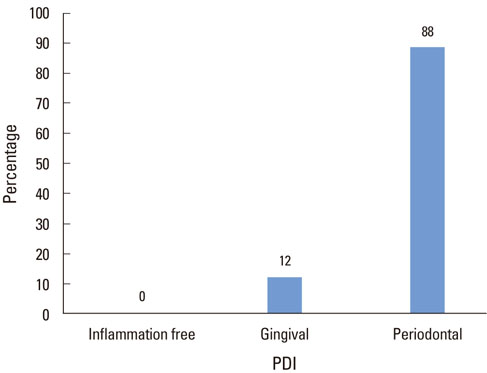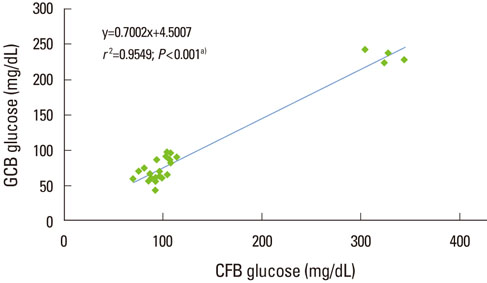J Periodontal Implant Sci.
2013 Feb;43(1):37-40. 10.5051/jpis.2013.43.1.37.
Screening for diabetes mellitus using gingival crevicular blood with the help of a self-monitoring device
- Affiliations
-
- 1Department of Periodontics, Tatyasaheb Kore Dental College and Research Centre, Kolhapur, India. dr.spg24@gmail.com
- 2Department of Periodontics, Yogita Dental College and Hospital, Ratnagiri, India.
- KMID: 1783676
- DOI: http://doi.org/10.5051/jpis.2013.43.1.37
Abstract
- PURPOSE
The purpose of study was to compare blood glucose in capillary finger-prick blood and gingival crevice blood using a self-monitoring blood glucose device among patients with gingivitis or periodontitis.
METHODS
Thirty patients with gingivitis or periodontitis and bleeding on probing (BOP) were chosen. The following clinical periodontal parameters were noted: probing depth, BOP, gingival bleeding index, and periodontal disease index. Blood samples were collected from gingival crevicular blood (GCB) and capillary finger-prick blood (CFB). These samples were analyzed using a glucose self-monitoring device.
RESULTS
Descriptive statistical analysis has been carried out in the present study. Data were analyzed using a Pearson's correlation coefficient and Student's t-test. A r-value of 0.97 shows very strong correlation between CFB and GCB, which was statistically highly significant (P<0.0001).
CONCLUSIONS
The authors conclude that GCB may serve as potential source of screening blood glucose during routine periodontal examination in populations with an unknown history of diabetes mellitus.
MeSH Terms
Figure
Reference
-
1. Wild S, Roglic G, Green A, Sicree R, King H. Global prevalence of diabetes: estimates for the year 2000 and projections for 2030. Diabetes Care. 2004. 27:1047–1053.
Article2. Express Healthcare. Diabetes in India: current status [Internet]. c2001. cited 2012 Feb 16. Mumbai: Express Healthcare;Available from: http://healthcare.financialexpress.com/200808/diabetes02.shtml.3. Harris MI, Eastman RC. Early detection of undiagnosed diabetes mellitus: a US perspective. Diabetes Metab Res Rev. 2000. 16:230–236.
Article4. Glümer C, Yuyun M, Griffin S, Farewell D, Spiegelhalter D, Kinmonth AL, et al. What determines the cost-effectiveness of diabetes screening? Diabetologia. 2006. 49:1536–1544.
Article5. Ward S, Simpson E, Davis S, Hind D, Rees A, Wilkinson A. Taxanes for the adjuvant treatment of early breast cancer: systematic review and economic evaluation. Health Technol Assess. 2007. 11:1–144.
Article6. Wee LE, Koh GC. The effect of neighborhood, socioeconomic status and a community-based program on multi-disease health screening in an Asian population: a controlled intervention study. Prev Med. 2011. 53:64–69.
Article7. Grossi SG, Genco RJ. Periodontal disease and diabetes mellitus: a two-way relationship. Ann Periodontol. 1998. 3:51–61.
Article8. Mealey BL, Rethman MP. Periodontal disease and diabetes mellitus. Bidirectional relationship. Dent Today. 2003. 22:107–113.9. Gurav A, Jadhav V. Periodontitis and risk of diabetes mellitus. J Diabetes. 2011. 3:21–28.
Article10. Ainamo J, Bay I. Problems and proposals for recording gingivitis and plaque. Int Dent J. 1975. 25:229–235.11. Ramfjord SP. The Periodontal Disease Index (PDI). J Periodontol. 1967. 38:Suppl:602–Suppl:610.
Article12. Parker RC, Rapley JW, Isley W, Spencer P, Killoy WJ. Gingival crevicular blood for assessment of blood glucose in diabetic patients. J Periodontol. 1993. 64:666–672.
Article13. American Diabetes Association. Standards of medical care in diabetes: 2007. Diabetes Care. 2007. 30:Suppl 1. S4–S41.14. Diabetes India. The Indian task force on diabetes care in India [Internet]. cited 2012 Feb 17. Diabetes India;Available from: http://www.diabetesindia.com/diabetes/itfdci.htm.15. Loe H. Periodontal disease. The sixth complication of diabetes mellitus. Diabetes Care. 1993. 16:329–334.
Article16. Shetty S, Kohad R, Yeltiwar R, Shetty K. Gingival blood glucose estimation with reagent test strips: a method to detect diabetes in a periodontal population. J Periodontol. 2011. 82:1548–1555.
Article17. Strauss SM, Wheeler AJ, Russell SL, Brodsky A, Davidson RM, Gluzman R, et al. The potential use of gingival crevicular blood for measuring glucose to screen for diabetes: an examination based on characteristics of the blood collection site. J Periodontol. 2009. 80:907–914.
Article18. Sarlati F, Pakmehr E, Khoshru K, Akhondi N. Gingival crevicular blood for assessment of blood glucose levels. J Periodontol Implant Dent. 2010. 2:17–24.19. Parker RC, Rapley JW, Isley W, Spencer P, Killoy WJ. Gingival crevicular blood for assessment of blood glucose in diabetic patients. J Periodontol. 1993. 64:666–672.
Article20. Beikler T, Kuczek A, Petersilka G, Flemmig TF. In-dental-office screening for diabetes mellitus using gingival crevicular blood. J Clin Periodontol. 2002. 29:216–218.
Article21. Khader YS, Al-Zubi BN, Judeh A, Rayyan M. Screening for type 2 diabetes mellitus using gingival crevicular blood. Int J Dent Hyg. 2006. 4:179–182.
Article22. Muller HP, Behbehani E. Methods for measuring agreement: glucose levels in gingival crevice blood. Clin Oral Investig. 2005. 9:65–69.
Article
- Full Text Links
- Actions
-
Cited
- CITED
-
- Close
- Share
- Similar articles
-
- Study on the correlation of periodontopathic microflora and gingival crevicular fluid cytokine on periodontal disease progression
- Glucose Management Using Continuous Glucose Monitors
- Dynamics of gingival crevicular fluid volume and enzyme activities after application of orthodontic force
- Comparative volumetric and clinical evaluation of peri-implant sulcular fluid and gingival crevicular fluid
- Self-Monitoring of Blood Glucose in Patients with Insulin-Treated Type 2 Diabetes Mellitus



